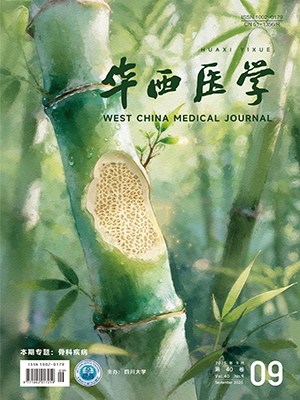| 1. |
Shane AL, Sánchez PJ, Stoll BJ. Neonatal sepsis. Lancet, 2017, 390(10104): 1770‐1780.
|
| 2. |
leischmann-Struzek C, Goldfarb DM, Schlattmann P, et al. The global burden of paediatric and neonatal sepsis: a systematic review. Lancet Respir Med, 2018, 6(3): 223‐230.
|
| 3. |
Wagstaff JS, Durrant RJ, Newman MG, et al. Antibiotic treatment of suspected and confirmed neonatal sepsis within 28 days of birth: a retrospective analysis. Front Pharmacol, 2019, 10: 1191.
|
| 4. |
中華醫學會兒科學分會新生兒學組, 中國醫師協會新生兒科醫師分會感染專業委員會. 新生兒敗血癥診斷及治療專家共識(2019 年版). 中華兒科雜志, 2019, 57(4): 252-257.
|
| 5. |
中華醫學會急診學分會兒科學組, 中華醫學會兒科學分會急診血組、新生兒學組. 新生兒危重病例評分法(草案). 中華兒科雜志, 2001, 39(1): 42-43.
|
| 6. |
Dong Y, Speer CP. Late-onset neonatal sepsis: recent developments. Arch Dis Child Fetal Neonatal Ed, 2015, 100(3): F257‐F263.
|
| 7. |
劉慧強, 童笑梅. 極低/超低出生體重兒晚發敗血癥的臨床分析. 中國當代兒科雜志, 2019, 21(10): 1038‐1043.
|
| 8. |
Patel P, Bhatia J. Total parenteral nutrition for the very low birth weight infant. Semin Fetal Neonatal Med, 2017, 22(1): 2‐7.
|
| 9. |
Lapillonne A, Fidler Mis N, Goulet O, et al. ESPGHAN/ESPEN/ESPR/CSPEN guidelines on pediatric parenteral nutrition: lipids. Clin Nutr, 2018, 37(6 Pt B): 2324‐2336.
|
| 10. |
Alcock G, Liley HG, Cooke L, et al. Prevention of neonatal late-onset sepsis: a randomised controlled trial. BMC Pediatr, 2017, 17(1): 98.
|
| 11. |
El Manouni El Hassani S, Berkhout DJC, Niemarkt HJ, et al. Risk factors for late-onset sepsis in preterm infants: a multicenter case-control study. Neonatology, 2019, 116(1): 42‐51.
|
| 12. |
Shaw AG, Sim K, Randell P, et al. Late-onset bloodstream infection and perturbed maturation of the gastrointestinal microbiota in premature infants. PLoS One, 2015, 10(7): e0132923.
|
| 13. |
楚燕芳, 余加林, 杜立中. 區分早發型和晚發型新生兒敗血癥的臨床意義. 中華實用兒科臨床雜志, 2015, 30(10): 743-746.
|
| 14. |
陳瀟, 富建華. 新生兒敗血癥 229 例臨床特點、病原學分布及轉歸分析. 中華實用兒科臨床雜志, 2019, 34(10): 740-744.
|
| 15. |
Heida FH, Hulscher JB, Schurink M, et al. Bloodstream infections during the onset of necrotizing enterocolitis and their relation with the pro-inflammatory response, gut wall integrity and severity of disease in NEC. J Pediatr Surg, 2015, 50(11): 1837‐1841.
|
| 16. |
Dong Y, Speer CP. The role of Staphylococcus epidermidis in neonatal sepsis: guarding angel or pathogenic devil?. Int J Med Microbiol, 2014, 304(5/6): 513-520.
|
| 17. |
Heo JS, Shin SH, Jung YH, et al. Neonatal sepsis in a rapidly growing, tertiary neonatal intensive care unit: trends over 18 years. Pediatr Int, 2015, 57(5): 909‐916.
|
| 18. |
Nour I, Eldegla HE, Nasef N, et al. Risk factors and clinical outcomes for carbapenem-resistant Gram-negative late-onset sepsis in a neonatal intensive care unit. J Hosp Infect, 2017, 97(1): 52‐58.
|
| 19. |
崔雪薇, 薛辛東. 降鈣素原及 C-反應蛋白聯合檢測在新生兒院內感染早期診斷中的意義. 中國小兒急救醫學, 2016, 23(4): 222-226.
|
| 20. |
Ree IMC, Fustolo-Gunnink SF, Bekker V, et al. Thrombocytopenia in neonatal sepsis: incidence, severity and risk factors. PLoS One, 2017, 12(10): e0185581.
|




